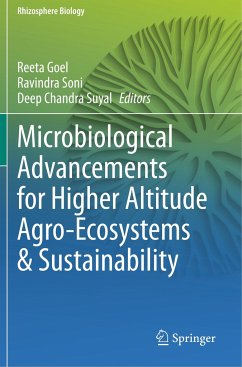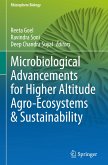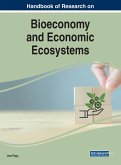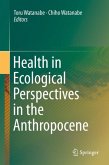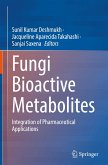Microbiological Advancements for Higher Altitude Agro-Ecosystems & Sustainability
Herausgegeben:Goel, Reeta; Soni, Ravindra; Suyal, Deep Chandra
Microbiological Advancements for Higher Altitude Agro-Ecosystems & Sustainability
Herausgegeben:Goel, Reeta; Soni, Ravindra; Suyal, Deep Chandra
- Broschiertes Buch
- Merkliste
- Auf die Merkliste
- Bewerten Bewerten
- Teilen
- Produkt teilen
- Produkterinnerung
- Produkterinnerung
The book explores the challenges and opportunities associated with high-altitude agro-ecosystems and the factors that influence them. It discusses the various indigenous agricultural practices and approaches, as well as the microbiology of mountain & hill agro-ecosystems, providing a comprehensive overview of the various factors that control the microbiome at high altitudes. The contributions examine microbiological advances, such as use of "omics" technologies for hill agriculture and environmental sustainability, and explore the use of nanotechnology for agricultural and environmental…mehr
Andere Kunden interessierten sich auch für
![Microbiological Advancements for Higher Altitude Agro-Ecosystems & Sustainability Microbiological Advancements for Higher Altitude Agro-Ecosystems & Sustainability]() Microbiological Advancements for Higher Altitude Agro-Ecosystems & Sustainability77,99 €
Microbiological Advancements for Higher Altitude Agro-Ecosystems & Sustainability77,99 €![Forensic DNA Typing: Principles, Applications and Advancements Forensic DNA Typing: Principles, Applications and Advancements]() Forensic DNA Typing: Principles, Applications and Advancements194,99 €
Forensic DNA Typing: Principles, Applications and Advancements194,99 €![Handbook of Research on Bioeconomy and Economic Ecosystems Handbook of Research on Bioeconomy and Economic Ecosystems]() Handbook of Research on Bioeconomy and Economic Ecosystems309,99 €
Handbook of Research on Bioeconomy and Economic Ecosystems309,99 €![Lead Toxicity: Challenges and Solution Lead Toxicity: Challenges and Solution]() Lead Toxicity: Challenges and Solution154,99 €
Lead Toxicity: Challenges and Solution154,99 €![Health in Ecological Perspectives in the Anthropocene Health in Ecological Perspectives in the Anthropocene]() Health in Ecological Perspectives in the Anthropocene77,99 €
Health in Ecological Perspectives in the Anthropocene77,99 €![Novel Technologies in Biosystems, Biomedical & Drug Delivery Novel Technologies in Biosystems, Biomedical & Drug Delivery]() Novel Technologies in Biosystems, Biomedical & Drug Delivery108,99 €
Novel Technologies in Biosystems, Biomedical & Drug Delivery108,99 €![Fungi Bioactive Metabolites Fungi Bioactive Metabolites]() Fungi Bioactive Metabolites161,99 €
Fungi Bioactive Metabolites161,99 €-
-
-
The book explores the challenges and opportunities associated with high-altitude agro-ecosystems and the factors that influence them. It discusses the various indigenous agricultural practices and approaches, as well as the microbiology of mountain & hill agro-ecosystems, providing a comprehensive overview of the various factors that control the microbiome at high altitudes.
The contributions examine microbiological advances, such as use of "omics" technologies for hill agriculture and environmental sustainability, and explore the use of nanotechnology for agricultural and environmental sustainability at higher altitudes. The book also describes various aspects of low-temperature microbiology in the context of high-altitude farming and environmental sustainability.
The contributions examine microbiological advances, such as use of "omics" technologies for hill agriculture and environmental sustainability, and explore the use of nanotechnology for agricultural and environmental sustainability at higher altitudes. The book also describes various aspects of low-temperature microbiology in the context of high-altitude farming and environmental sustainability.
Produktdetails
- Produktdetails
- Rhizosphere Biology
- Verlag: Springer / Springer Nature Singapore / Springer, Berlin
- Artikelnr. des Verlages: 978-981-15-1904-8
- 1st edition 2020
- Seitenzahl: 508
- Erscheinungstermin: 14. März 2021
- Englisch
- Abmessung: 235mm x 155mm x 26mm
- Gewicht: 869g
- ISBN-13: 9789811519048
- ISBN-10: 9811519048
- Artikelnr.: 61201859
- Herstellerkennzeichnung Die Herstellerinformationen sind derzeit nicht verfügbar.
- Rhizosphere Biology
- Verlag: Springer / Springer Nature Singapore / Springer, Berlin
- Artikelnr. des Verlages: 978-981-15-1904-8
- 1st edition 2020
- Seitenzahl: 508
- Erscheinungstermin: 14. März 2021
- Englisch
- Abmessung: 235mm x 155mm x 26mm
- Gewicht: 869g
- ISBN-13: 9789811519048
- ISBN-10: 9811519048
- Artikelnr.: 61201859
- Herstellerkennzeichnung Die Herstellerinformationen sind derzeit nicht verfügbar.
Dr. Reeta Goel is a Professor & Head of the Department of Microbiology, G. B. Pant University of Agriculture & Technology, Uttrakhand, India. She has also served as a visiting scientist at various institutes in the USA and has more than 35 years of teaching and research experience in the area of plant-microbe interactions, microbial ecology, bio-degradation and metagenomics, especially with reference to higher altitudes. Moreover, she has worked extensively in the field of genomics and proteomics of cold adapted microorganisms. She has published over 100 research articles, book chapters and edited books. She holds three patents; including one U.S. Patent and three are filed. She has received numerous National and International awards for her contributions to science & technology. Dr. Ravindra Soni is an Assistant Professor at the Department of Agricultural Microbiology, I.G.K.V., Raipur, India. He has more than 10 years of teaching & research experience in the field ofagricultural microbiology, microbial ecology, molecular biology & biotechnology, especially with reference of higher altitudes. He has published several research articles and chapters in respected international journals and books. He has filed one patent. Dr. Deep Chandra Suyal is an Assistant Professor at the Department of Microbiology, Eternal University, Baru Sahib, Sirmaur, Himachal Pradesh (India). He has been actively engaged in research for 9 years, and has experience in the fields of agricultural microbiology, molecular biology & biotechnology and metagenomics. He is currently investigating the genomics & proteomics of cold adapted microorganisms. He has published numerous articles in respected international journals, and filed three patents.
Chapter 1. High altitude agro-ecosystems: Challenges & Opportunities._ Chapter 2. An Overview of Indian Agriculture with Focus on Challenges and Opportunities in North East._ Chapter 3. Sari System: A Traditional Cropping Pattern of the Uttarakhand Himalaya._ Chapter 4. Factors influencing soil ecosystem and agriculture productivity at higher altitudes._ Chapter 5. Traditional farming systems and agro-biodiversity in Eastern Himalayan region of India._ Chapter 6. Indigenous Agricultural Practices: A Supreme Key to Maintaining Biodiversity._ Chapter 7. Management of biotic and abiotic stress affecting agricultural productivity using beneficial microorganisms isolated from higher altitude agro-ecosystems: A remedy for sustainable agriculture._ Chapter 8. Microbial diversity in North Western Himalayan agroecosystems: Functions and applications._ Chapter 9. Biodiversity of Microbial Community: Association With Sustainable Hill Agroecosystems._ Chapter 10. Soil microbiota: A key bioagent for revitalization of soil health in hilly regions._ Chapter 11. Characteristics of microbial community and enzyme activities in higher altitude regions._ Chapter 12. Psychrotolerant Microbes: characterization, conservation, strain improvements, mass production & commercialization._ Chapter 13. Understanding cold-adapted plant growth promoting microorganisms from high altitude ecosystems._ Chapter 14. Microbes for cold stress resistance in plants: Mechanism, opportunities and challenges._ 15. Nutrient Cycling at Higher Altitudes._ Chapter 16. Assessment of Genes And Enzymes of Microorganisms of High Altitudes And Their Application In Agriculture._ 17. Microbiological advances in bioactives from high altitude._ Chapter 18. Bio-prospecting of endophytic microbes from higher altitude plants: Recent advances and their biotechnological applications._ Chapter 19. Biosensor: A boon for heavy metals detection in natural water reservoirs at higher altitudes._ Chapter 20. Frankia: A Promising N-Fixing Plant Growth Promoting Rhizobacteria (PGPR) Improved Drought Tolerance in Crops at Higher Altitude._ Chapter 21. Preservation of Fungal Culture with Special Reference to Mineral Oil Preservation._ Chapter 22. Applications of advanced Omics Technology for harnessing the high altitude agriculture production._ Chapter 23.Nanotechnology for agricultural and environmental sustainability at higher altitudes.
Chapter 1. High altitude agro-ecosystems: Challenges & Opportunities._ Chapter 2. An Overview of Indian Agriculture with Focus on Challenges and Opportunities in North East._ Chapter 3. Sari System: A Traditional Cropping Pattern of the Uttarakhand Himalaya._ Chapter 4. Factors influencing soil ecosystem and agriculture productivity at higher altitudes._ Chapter 5. Traditional farming systems and agro-biodiversity in Eastern Himalayan region of India._ Chapter 6. Indigenous Agricultural Practices: A Supreme Key to Maintaining Biodiversity._ Chapter 7. Management of biotic and abiotic stress affecting agricultural productivity using beneficial microorganisms isolated from higher altitude agro-ecosystems: A remedy for sustainable agriculture._ Chapter 8. Microbial diversity in North Western Himalayan agroecosystems: Functions and applications._ Chapter 9. Biodiversity of Microbial Community: Association With Sustainable Hill Agroecosystems._ Chapter 10. Soil microbiota: A key bioagent for revitalization of soil health in hilly regions._ Chapter 11. Characteristics of microbial community and enzyme activities in higher altitude regions._ Chapter 12. Psychrotolerant Microbes: characterization, conservation, strain improvements, mass production & commercialization._ Chapter 13. Understanding cold-adapted plant growth promoting microorganisms from high altitude ecosystems._ Chapter 14. Microbes for cold stress resistance in plants: Mechanism, opportunities and challenges._ 15. Nutrient Cycling at Higher Altitudes._ Chapter 16. Assessment of Genes And Enzymes of Microorganisms of High Altitudes And Their Application In Agriculture._ 17. Microbiological advances in bioactives from high altitude._ Chapter 18. Bio-prospecting of endophytic microbes from higher altitude plants: Recent advances and their biotechnological applications._ Chapter 19. Biosensor: A boon for heavy metals detection in natural water reservoirs at higher altitudes._ Chapter 20. Frankia: A Promising N-Fixing Plant Growth Promoting Rhizobacteria (PGPR) Improved Drought Tolerance in Crops at Higher Altitude._ Chapter 21. Preservation of Fungal Culture with Special Reference to Mineral Oil Preservation._ Chapter 22. Applications of advanced Omics Technology for harnessing the high altitude agriculture production._ Chapter 23.Nanotechnology for agricultural and environmental sustainability at higher altitudes.

